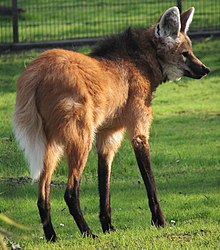| Maned wolf[1] Temporal range: Late Pleistocene – Recent
| |
|---|---|

| |
| Maned wolf in Cologne Zoo, Germany | |
| Scientific classification | |
| Domain: | Eukaryota |
| Kingdom: | Animalia |
| Phylum: | Chordata |
| Class: | Mammalia |
| Order: | Carnivora |
| Family: | Canidae |
| Subfamily: | Caninae |
| Tribe: | Canini |
| Genus: | Chrysocyon Smith, 1839 |
| Species: | C. brachyurus
|
| Binomial name | |
| Chrysocyon brachyurus (Illiger, 1815)
| |

| |
| Range of the maned wolf | |
| Synonyms[4] | |
|
Canis brachyurus, C. campestris, C. isodactylus, C. jubatus, Vulpes cancrosa | |
The maned wolf (Chrysocyon brachyurus) is a large canine of South America.[5] It is found in Argentina, Brazil, Bolivia, Peru, and Paraguay, and is almost extinct in Uruguay. Its markings resemble those of foxes, but it is neither a fox nor a wolf.[6] It is the only species in the genus Chrysocyon (meaning "golden dog" in Ancient Greek: χρῡσο-κύων: chryso-kyōn).
It is the largest canine in South America, weighing 20–30 kg (44–66 lb) and up to 110 cm (43 in) at the withers. Its long, thin legs and dense reddish coat give it a distinct appearance. The maned wolf is a crepuscular and omnivorous animal adapted to the open environments of the South American savanna, with an important role in the seed dispersal of fruits, especially the wolf apple (Solanum lycocarpum). The maned wolf is a solitary animal. It communicates primarily by scent marking, but also gives a loud call known as "roar-barking".
This mammal lives in open and semi-open habitats, especially grasslands with scattered bushes and trees, in the Cerrado of south, central-west, and southeastern Brazil; Paraguay; northern Argentina; and Bolivia east and north of the Andes,[7] and far southeastern Peru (Pampas del Heath only).[8] It is very rare in Uruguay, possibly being displaced completely through loss of habitat.[2] The International Union for Conservation of Nature lists it as near threatened,[2] while it is considered a vulnerable species by the Brazilian Institute of Environment and Renewable Natural Resources. In 2011, a female maned wolf, run over by a truck, underwent stem cell treatment at the Zoo Brasília, this being the first recorded case of the use of stem cells to heal injuries in a wild animal.[9]
- ^ Wozencraft, W. C. (2005). "Order Carnivora". In Wilson, D. E.; Reeder, D. M. (eds.). Mammal Species of the World: A Taxonomic and Geographic Reference (3rd ed.). Johns Hopkins University Press. pp. 532–628. ISBN 978-0-8018-8221-0. OCLC 62265494.
- ^ a b c Paula, R.C.; DeMatteo, K. (2016) [errata version of 2015 assessment]. "Chrysocyon brachyurus". IUCN Red List of Threatened Species. 2015: e.T4819A88135664. doi:10.2305/IUCN.UK.2015-4.RLTS.T4819A82316878.en. Retrieved 18 February 2022.
- ^ "Appendices | CITES". cites.org. Retrieved 2022-01-14.
- ^ Osgood, Wilfred H. (1919). "Names of Some South American Mammals". Journal of Mammalogy. 1 (1): 33–36. doi:10.2307/1373718. JSTOR 1373718.
- ^ Dietz, James M. (24 May 1985). "Chrysocyon brachyurus" (PDF). Mammalian Species (234). The American Society of Mammalogists: 1–4. doi:10.2307/3503796. JSTOR 3503796.
- ^ "Maned wolf is a strange cross between a fox and a deer, and you've never seen anything like it". www.yahoo.com. 8 July 2022. Retrieved 2022-07-09.
- ^ Langguth, A. (1975). "Ecology and evolution in the South American canids". In Fox, M. W. (ed.). The wild canids: their systematics, behavioral ecology and evolution. New York: Van Nostrand Reinhold Company. pp. 192–206. ISBN 978-0442224301. OL 5059407M.
- ^ Rodden, M.; Rodrigues, F.; Bestelmeyer, S. (2004). "Chapter 3. South America (Neotropical)" (PDF). In Sillero-Zubiri, C.; Hoffmann, M.; Macdonald, D.W. (eds.). Canids: Foxes, Wolves, Jackals and Dogs. Status Survey and Conservation Action Plan. Gland, Switzerland and Cambridge, UK: IUCN/SSC Canid Specialist Group. pp. 26–80. ISBN 2-8317-0786-2.
- ^ Boyle, Rebecca (January 15, 2011). "Injured Brazilian Wolf Is First Wild Animal Treated With Stem Cells". Popular Science. Retrieved 2021-08-06.
